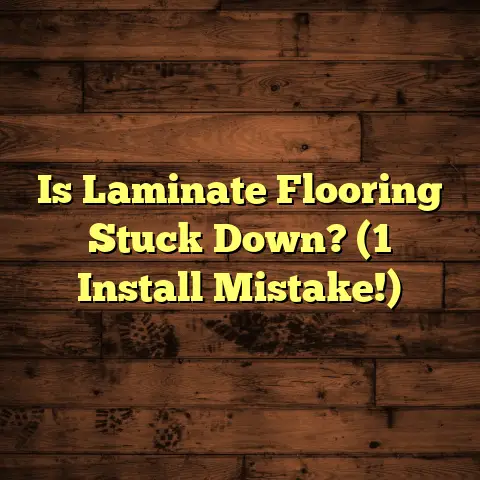Fix Pitted Garage Floors: How To? (2 Epoxy Errors!)
Imagine a garage floor so rough it snags your shoes, so stained it looks like a Jackson Pollock painting gone wrong, and so pitted it’s a tripping hazard. Not exactly the welcoming entrance you want for your home, right?
But here’s the good news: you can fix it! With a little elbow grease and the right knowledge, you can transform that eyesore into a smooth, durable, and even stylish surface with an epoxy coating. I’m talking about a garage floor that not only looks great but also adds value to your home and makes working in your garage a heck of a lot more enjoyable.
So, grab a cup of coffee (or your favorite beverage) and let’s dive into how to fix those pitted garage floors and avoid some common epoxy pitfalls. Trust me, your garage will thank you!
Section 1: Understanding Pitted Garage Floors
What Causes Pitting?
Pitting in garage floors is like concrete’s version of acne – annoying and often a sign of underlying issues. So, what causes these unsightly blemishes?
-
Moisture: Concrete is porous, meaning it absorbs moisture. When water seeps in and freezes, it expands, creating pressure that can flake off the surface. This freeze-thaw cycle is a major culprit, especially in colder climates.
-
Heavy Vehicular Traffic: Let’s face it, garage floors take a beating. The weight of vehicles, especially SUVs and trucks, puts immense pressure on the concrete. Over time, this can weaken the surface and lead to pitting and cracking.
-
Chemical Spills: Oil, gasoline, antifreeze, battery acid – the list of potentially corrosive chemicals that can spill in a garage is long. These chemicals can react with the concrete, weakening it and causing it to deteriorate. According to the Portland Cement Association, certain acids can dissolve the calcium hydroxide in concrete, leading to significant damage.
-
Aging Concrete: Like everything else, concrete ages. Over time, the cement paste that binds the aggregate together can weaken, making the surface more susceptible to damage.
Think of it this way: concrete is a bit like a sponge. It soaks up everything, good and bad. Over time, that constant exposure to moisture, chemicals, and heavy loads takes its toll.
The Importance of Addressing Pitting
Ignoring pitted garage floors is like ignoring a toothache – it won’t get better on its own, and it’ll likely get worse. Why is it so crucial to address pitting promptly?
-
Safety Hazards: Pits and cracks create uneven surfaces that can be tripping hazards. I’ve seen too many people stumble and fall in garages with neglected floors. Plus, loose concrete chips can be slippery.
-
Aesthetic Concerns: Let’s be honest, a pitted garage floor is just plain ugly. It detracts from the overall appearance of your home and can make your garage feel dingy and uninviting.
-
Long-Term Damage: Pitting is often a sign of deeper problems. If left untreated, moisture can penetrate further into the concrete, leading to more extensive damage and potentially compromising the structural integrity of the floor. It’s like a small leak in a roof – if you don’t fix it, it’ll eventually cause major problems.
Bottom line: addressing pitting early is an investment in the safety, appearance, and longevity of your garage floor.
Section 2: Preparing for the Transformation
Okay, so you’ve decided to tackle that pitted garage floor. Awesome! But before you start slinging epoxy, you need to do some prep work. Think of it as laying the foundation for a successful project.
Assessing the Extent of Damage
First, let’s play detective and assess the extent of the damage. Grab a notepad and pen, and let’s get to work.
-
Visual Inspection: Start by giving your garage floor a good once-over. Look for:
- Cracks: Are they hairline cracks or wider, deeper cracks?
- Pits: How many pits are there? How deep and wide are they?
- Stains: What types of stains are present (oil, grease, rust, etc.)?
- Dusting: Do you notice a powdery residue on the surface? This can indicate weak concrete.
- Sound Test: Tap the floor with a hammer or metal object. A solid sound indicates healthy concrete, while a hollow sound suggests delamination (separation of layers).
- Moisture Test: Tape a square of plastic wrap to the floor and leave it for 24 hours. If moisture appears underneath the plastic, your floor has a moisture problem that needs to be addressed before applying epoxy.
- The DIY or Pro Question:
- Minor Pitting: If you have a few small pits and hairline cracks, you can likely handle the repair yourself.
- Extensive Damage: If you have large, deep cracks, widespread pitting, or signs of structural damage, it’s best to consult a professional.
Gathering the Right Tools and Materials
Now that you know what you’re dealing with, it’s time to gather your supplies. Here’s a list of essentials:
- Cleaning Supplies:
- Degreaser: A good quality degreaser to remove oil and grease stains. I recommend Simple Green or Krud Kutter.
- Concrete Cleaner: A cleaner specifically designed for concrete. TSP (trisodium phosphate) is a classic choice, but be sure to follow safety precautions.
- Pressure Washer: A pressure washer will make quick work of removing dirt and debris.
- Scrub Brush: A stiff-bristled scrub brush for scrubbing stubborn stains.
- Repair Materials:
- Epoxy Patching Compound: To fill in the pits and cracks. I prefer a two-part epoxy patching compound for its strength and durability.
- Epoxy Primer: An epoxy primer helps the epoxy coating adhere to the concrete.
- Epoxy Coating: The star of the show! Choose a high-quality, 100% solids epoxy coating for the best results. Water-based epoxies are easier to work with, but solvent-based epoxies are more durable.
- Sealer (Optional): A clear sealer can add an extra layer of protection and enhance the shine of the epoxy coating.
- Tools:
- Mixing Buckets: For mixing the epoxy and patching compound.
- Mixing Sticks: For stirring the mixtures thoroughly.
- Trowel or Putty Knife: For applying the patching compound.
- Epoxy Roller: A special roller designed for applying epoxy coatings.
- Paint Brush: For edging and hard-to-reach areas.
- Spiked Shoes (Optional): For walking on the epoxy while it’s still wet.
- Safety Gear:
- Safety Glasses: To protect your eyes from splashes and debris.
- Gloves: Chemical-resistant gloves to protect your skin from the epoxy and cleaners.
- Respirator: A respirator to protect your lungs from epoxy fumes.
Section 3: The Repair Process
Alright, you’ve assessed the damage and gathered your tools. Now it’s time to get your hands dirty!
Step 1: Cleaning the Garage Floor
A clean surface is crucial for proper epoxy adhesion. Think of it like painting – you wouldn’t paint over dirt and grime, would you?
- Remove Everything: Clear everything out of your garage – cars, tools, boxes, everything!
- Sweep and Vacuum: Sweep up loose debris and vacuum the entire floor to remove dust and dirt.
- Degrease: Apply degreaser to any oil or grease stains and let it sit for the recommended time. Scrub with a stiff-bristled brush and rinse thoroughly.
- Concrete Cleaner: Apply concrete cleaner to the entire floor and scrub with a brush. Rinse thoroughly.
- Pressure Wash: Pressure wash the floor to remove any remaining dirt and debris. Be sure to use a wide nozzle to avoid damaging the concrete.
- Rinse and Dry: Rinse the floor thoroughly and let it dry completely. This could take 24-48 hours, depending on the humidity.
Step 2: Filling the Pits
Now it’s time to fill those unsightly pits and cracks.
- Mix the Patching Compound: Follow the manufacturer’s instructions to mix the epoxy patching compound. Be sure to mix it thoroughly to ensure proper curing.
- Apply the Compound: Use a trowel or putty knife to apply the patching compound to the pits and cracks. Overfill slightly to allow for sanding.
- Smooth the Surface: Use the trowel or putty knife to smooth the surface of the patching compound.
- Let it Cure: Allow the patching compound to cure completely according to the manufacturer’s instructions.
- Sand the Surface: Once the patching compound is cured, sand it smooth with a sanding block or orbital sander.
Step 3: Applying the Epoxy Coating
This is where the magic happens! Applying the epoxy coating will transform your garage floor from drab to fab.
- Apply Primer: Apply a thin, even coat of epoxy primer to the entire floor using an epoxy roller. This will help the epoxy coating adhere properly. Let the primer dry completely according to the manufacturer’s instructions.
- Mix the Epoxy: Follow the manufacturer’s instructions to mix the epoxy coating. Be sure to mix it thoroughly to ensure proper curing.
- Apply the First Coat: Pour a small amount of epoxy onto the floor and spread it evenly using an epoxy roller. Work in small sections to avoid getting overwhelmed.
- Spiked Shoes (Optional): If you’re using spiked shoes, you can walk on the epoxy while it’s still wet to remove any air bubbles.
- Let it Cure: Allow the first coat of epoxy to cure completely according to the manufacturer’s instructions.
- Apply the Second Coat (Optional): For added durability and shine, apply a second coat of epoxy using the same method as the first coat.
- Let it Cure: Allow the second coat of epoxy to cure completely according to the manufacturer’s instructions.
Section 4: Common Epoxy Errors to Avoid
Epoxy coatings can be tricky, and even experienced DIYers can make mistakes. Here are two common errors to avoid:
Error 1: Inadequate Surface Preparation
This is the number one reason why epoxy coatings fail. If you don’t properly prepare the surface, the epoxy won’t adhere properly, and it will eventually peel or flake off.
- The Problem: Oil, grease, dirt, and moisture can all prevent the epoxy from bonding to the concrete.
- The Solution: Follow the cleaning steps outlined above meticulously. Don’t skip any steps, and be sure to rinse the floor thoroughly. If you suspect moisture is a problem, perform a moisture test and address any issues before applying epoxy.
- Spotting the Issue: Look for peeling, flaking, or bubbling epoxy. These are all signs of adhesion failure.
Error 2: Incorrect Mixing Ratios
Epoxy is a two-part system, and the mixing ratios are crucial. If you don’t mix the epoxy properly, it won’t cure correctly, and it will be soft and sticky.
- The Problem: Using the wrong mixing ratios can result in an epoxy coating that is too soft, too brittle, or doesn’t cure at all.
- The Solution: Always follow the manufacturer’s instructions carefully. Use accurate measuring cups or scales to ensure you’re using the correct ratios. Mix the epoxy thoroughly for the recommended time.
- Spotting the Issue: The epoxy coating is still sticky or soft after the recommended curing time.
Section 5: Final Touches and Maintenance
Congratulations! You’ve successfully applied an epoxy coating to your garage floor. Now it’s time for the final touches and to learn how to maintain your new surface.
Sealing and Curing
Sealing the epoxy coating is optional, but it can add an extra layer of protection and enhance the shine.
- Apply Sealer (Optional): Apply a thin, even coat of clear sealer to the entire floor using an epoxy roller.
- Let it Cure: Allow the sealer to cure completely according to the manufacturer’s instructions.
- Curing Time: Resist the urge to drive your car into the garage immediately. Allow the epoxy coating to cure completely before using the garage. This could take several days, depending on the type of epoxy and the temperature.
Ongoing Care
To keep your garage floor looking its best, follow these simple maintenance tips:
- Sweep Regularly: Sweep the floor regularly to remove dirt and debris.
- Clean Spills Immediately: Clean up spills immediately to prevent staining.
- Use a Mild Detergent: When cleaning the floor, use a mild detergent and water. Avoid harsh chemicals or abrasive cleaners.
- Protect from Heavy Objects: Use mats or plywood to protect the floor from heavy objects or sharp edges.
Conclusion: The Rewards of Transformation
You did it! You’ve transformed your pitted garage floor into a smooth, durable, and aesthetically pleasing surface. Take a moment to admire your handiwork and enjoy the satisfaction of a job well done.
A revitalized garage floor not only looks great but also adds value to your home and makes working in your garage a more enjoyable experience. So, go ahead and take pride in your newly transformed garage. You deserve it!





